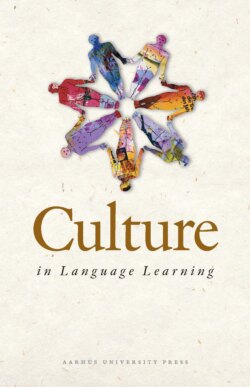Culture in Language Learning

Реклама. ООО «ЛитРес», ИНН: 7719571260.
Оглавление
Группа авторов. Culture in Language Learning
Introduction
BIBLIOGRAPHY
Culture in Language Teaching
1. CULTURE: AN INTEGRAL COMPONENT OF LANGUAGE TEACHING
2. THE CULTURAL DIMENSIONS OF LANGUAGE STUDY
2.1 THE MODERNIST PERSPECTIVE
2.1.1 A humanistic concept
2.1.2 A sociolinguistic concept
2.1.3 Intercultural education
2.2 THE POST-MODERNIST PERSPECTIVE
2.2.1 Culture as Discourse
2.2.2 Culture as identity
2.2.3 Culture as the moral right to be heard and listened to
3. NEW WAYS OF INTEGRATING LANGUAGE, CULTURE, HISTORY AND IDENTITY
3.1 FOREIGN LANGUAGES
3.2 HERITAGE LANGUAGES, SECOND LANGUAGES
3.3 RESIGNIFYING CULTURE AS HISTORICITY AND SUBJECTIVITY
BIBLIOGRAPHY
Culture in Language: A Transnational View
1. FOREIGN LANGUAGE TEACHING AS A LINGUISTIC AND CULTURAL CONTACT ZONE
2. LINGUISTIC FLOWS. 2.1 LINGUISTIC FLOWS IN SOCIAL NETWORKS
2.2 LINGUISTIC FLOWS IN TOUR DE FRANCE. 2.2.1 The target language
2.2.2 First languages
2.2.3 Other languages
2.2.4 Code-switching
3. LANGUACULTURAL FLOWS. 3.1 THE CONCEPT OF LANGUACULTURE
3.1.1 The semantics and pragmatics of language
3.1.2 The poetics of language
3.1.3 The identity dimension of language
3.1.4 Reasons for the introduction of the languaculture concept
3.1.5 Linguistic practice and linguistic resources
3.1.6 Languaculture in linguistic practice
3.1.7 Languaculture in linguistic resources
3.2 LANGUACULTURAL FLOWS IN TOUR DE FRANCE. 3.2.1 Semantics and pragmatics
3.2.2 Poetics
3.2.3 Linguistic identity
4. DISCURSIVE FLOWS. 4.1 DISCOURSE AND DOUBLE INTERTEXTUALITY
4.2 DISCURSIVE FLOWS IN TOUR DE FRANCE
5. OTHER CULTURAL FLOWS
5.1 LINGUISTIC, LANGUACULTURAL, DISCURSIVE, AND OTHER CULTURAL FLOWS IN TOUR DE FRANCE
5.1.1 Life forms
5.1.2 The market
5.1.3 The state
5.1.4 Social movements
6. CULTURE IN LANGUAGE: TWO LEVELS
NOTES
BIBLIOGRAPHY
Cultural and Historical Narrative in Native and Non-native Speaker Language
1. INTRODUCTION
2. BACKGROUND
3. CULTURAL AND HISTORICAL SUBJECTS IN NARRATION
4. WHAT CAN WE IMPROVE BY TEACHING?
BIBLIOGRAPHY
The Awareness of Context in Second Language Acquisition Theories
1. INTRODUCTION
2. A SOCIOLOGICAL MODEL
3. A LANGUAGE MODEL
4. SECOND LANGUAGE ACQUISITION THEORIES FROM A CRITICAL LEARNING PERSPECTIVE. 4.1 SLA THEORIES WITH FOCUS ON INNATENESS AND NATURAL LEARNING PROCESSES
4.2 SLA THEORIES WITH FOCUS ON INDIVIDUAL DIFFERENCES
4.3 MOTIVATION AND SLA
4.4 THE ACCULTURATION THEORY
5. ‘NATURAL’ LANGUAGE LEARNING
6. EXAMPLES FROM REAL LIFE
7. THE CONCEPT OF IDENTITY
8. THE THEORIES AND THE IMPACT OF CONTEXTUAL FACTORS – A SUMMARY
9. LANGUAGE AS LINGUISTIC STRUCTURE OR SOCIO-CULTURAL PRACTICE?
9.1 INTERACTION AND COMMUNICATIVE COMPETENCE
9.2 CULTURE AND LANGUAGE
10. NEW APPROACHES TO SECOND LANGUAGE ACQUISITION. 10.1 SLA AND THEORY BUILDING
10.2 AN ECOLOGICAL APPROACH TO SECOND LANGUAGE ACQUISITION
10.3 AFFORDANCE
11. PEDAGOGICAL PERSPECTIVES
12. CONCLUSION
13. EPILOQUE: THE DANGER OF CATEGORIES, OR HOW CATEGORIES NATURALIZE SLA THEORIES
NOTES
BIBLIOGRAPHY
Authenticity and Textbook Dialogues
1. GOALS IN FOREIGN LANGUAGE TEACHING
2. COMMUNICATION AND CULTURE
3. DIALOGUE IN BEGINNERS’ TEXTBOOKS
3.1 THE OVERALL IDEA OF PROGRESSION
3.2 INTERVIEWS
3.3 DIALOGUE
4. THE INTERPERSONAL META-FUNCTION
5. CONCLUSION
NOTES
BIBLIOGRAPHY
Beginners’ Textbooks
Video
Film Dialogue as a Resource for Promoting Language Awareness
1. INTRODUCTION: BACKGROUND ASSUMPTIONS, INSPIRING PRINCIPLES
1.1 EXPLICIT KNOWLEDGE ABOUT LANGUAGE AS A RESOURCE AND AS AN INSTRUCTIONAL PROBLEM
1.2 FILM DIALOGUE AS MODEL LANGUAGE
1.3 DIGITAL VIDEO AND SUBTITLES AS RESOURCES FOR OBSERVING LANGUAGE
2. OBSERVING AND DISCUSSING FILM DIALOGUE: SOME EXAMPLES
2.1 FACE WORK
2.2 INDIRECTNESS
2.3 SWEARING
2.4 SOCIO-CULTURAL IDENTITY IN LANGUAGE
2.5 WRITTEN VS. SPOKEN LANGUAGE: DISCUSSING THE LANGUAGE NORM
3. SUMMARY: WHAT DID WE FIND OUT?
NOTES
BIBLIOGRAPHY
Quoted films
APPENDIX: A TECHNICAL NOTE
Contributors
Отрывок из книги
Edited by
HANNE LETH ANDERSEN
.....
The term ‘culture’ has come to cover a host of phenomena that mean different things to different people: literate tradition or high C culture, level of civilization, way of life, ethnic membership, country of origin, nationality, ideology, religious affiliation, moral values. It is difficult to find a common objective denominator. However, in our contentious times, ‘culture’ has retained a sense of the irreducible, the sacred, that touches the core of who we are – our history and our subjectivity. Culture is embodied history. Theoretical perspectives on the cultural dimension of language research have thus drawn their inspiration from feminist and post-structuralist theories of the subject (Weedon 1987, Bourdieu 1991), and from theories of language as social semiotic practice (Kramsch 2002), as historical intertextual practice (Hanks 2000), as institutional and ritual practice (Rampton 1995), as discursive and conversational practice (Moermann 1988), and as ideological practice (Cameron 2000). These theories provide fruitful ways of bridging the individual and the social in language use. They enable us to see culture as that precarious third place where our historical and subjective self gets constructed across utterances and turns-at-talk between the self we have just been and the self we might still become.
Atkinson, D. 1999. ‘TESOL and culture’. TESOL Quarterly, 33(4), 625-65.
.....